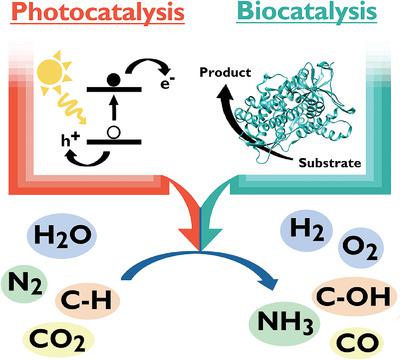当前位置:
X-MOL 学术
›
Biotechnol. Appl. Bioc.
›
论文详情
Our official English website, www.x-mol.net, welcomes your
feedback! (Note: you will need to create a separate account there.)
Light-driven catalysis with engineered enzymes and biomimetic systems.
Biotechnology and Applied Biochemistry ( IF 3.2 ) Pub Date : 2020-06-26 , DOI: 10.1002/bab.1976 Emily H Edwards 1 , Kara L Bren 1
Biotechnology and Applied Biochemistry ( IF 3.2 ) Pub Date : 2020-06-26 , DOI: 10.1002/bab.1976 Emily H Edwards 1 , Kara L Bren 1
Affiliation

|
Efforts to drive catalytic reactions with light, inspired by natural processes like photosynthesis, have a long history and have seen significant recent growth. Successfully engineering systems using biomolecular and bioinspired catalysts to carry out light‐driven chemical reactions capitalizes on advantages offered from the fields of biocatalysis and photocatalysis. In particular, driving reactions under mild conditions and in water, in which enzymes are operative, using sunlight as a renewable energy source yield environmentally friendly systems. Furthermore, using enzymes and bioinspired systems can take advantage of the high efficiency and specificity of biocatalysts. There are many challenges to overcome to fully capitalize on the potential of light‐driven biocatalysis. In this mini‐review, we discuss examples of enzymes and engineered biomolecular catalysts that are activated via electron transfer from a photosensitizer in a photocatalytic system. We place an emphasis on selected forefront chemical reactions of high interest, including CH oxidation, proton reduction, water oxidation, CO2 reduction, and N2 reduction.
中文翻译:

使用工程酶和仿生系统进行光驱动催化。
受光合作用等自然过程的启发,用光驱动催化反应的努力历史悠久,近期取得了显着增长。使用生物分子和仿生催化剂成功地设计系统来进行光驱动的化学反应利用了生物催化和光催化领域提供的优势。特别是,在温和的条件下和在水中(其中酶起作用)使用阳光作为可再生能源来驱动反应产生环境友好的系统。此外,使用酶和仿生系统可以利用生物催化剂的高效率和特异性。要充分利用光驱动生物催化的潜力,需要克服许多挑战。在这篇小评论中,我们讨论了酶和工程生物分子催化剂的例子,这些催化剂通过光催化系统中光敏剂的电子转移被激活。我们将重点放在选定的前沿化学反应上,包括 C H氧化、质子还原、水氧化、CO 2还原和N 2还原。
更新日期:2020-06-26
中文翻译:

使用工程酶和仿生系统进行光驱动催化。
受光合作用等自然过程的启发,用光驱动催化反应的努力历史悠久,近期取得了显着增长。使用生物分子和仿生催化剂成功地设计系统来进行光驱动的化学反应利用了生物催化和光催化领域提供的优势。特别是,在温和的条件下和在水中(其中酶起作用)使用阳光作为可再生能源来驱动反应产生环境友好的系统。此外,使用酶和仿生系统可以利用生物催化剂的高效率和特异性。要充分利用光驱动生物催化的潜力,需要克服许多挑战。在这篇小评论中,我们讨论了酶和工程生物分子催化剂的例子,这些催化剂通过光催化系统中光敏剂的电子转移被激活。我们将重点放在选定的前沿化学反应上,包括 C H氧化、质子还原、水氧化、CO 2还原和N 2还原。











































 京公网安备 11010802027423号
京公网安备 11010802027423号